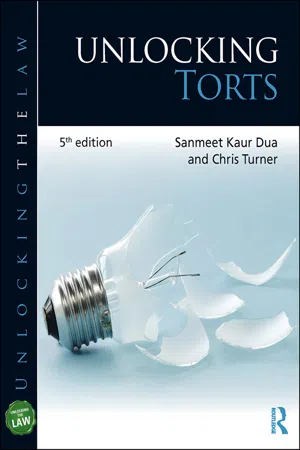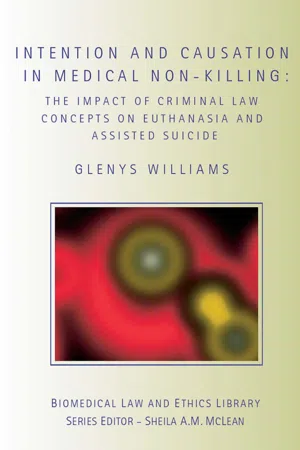Legal Causation
Legal causation refers to the link between a defendant's actions and the resulting harm to the plaintiff in a legal case. It involves determining whether the defendant's actions directly caused the harm and if they can be held legally responsible for it. Legal causation is a key element in establishing liability in tort and criminal law cases.
6 Key excerpts on "Legal Causation"
- eBook - ePub
- Lisa Cherkassky(Author)
- 2013(Publication Date)
- Routledge(Publisher)
...argue against the imposition of a general duty to act 2.4 Causation When a defendant is charged with a result crime (i.e. a crime that has a consequence such as grievous bodily harm), it is not enough to prove that the defendant had the actus reus and mens rea of that crime. He must also have caused the outcome. This is because sometimes a defendant can have both the actus reus and the mens rea of an offence, but the victim’s resulting injury was actually caused by something or someone else! Definition Causation: the defendant must cause the outcome. This doctrine is known as causation, and it means that the prosecution must prove that the defendant caused the outcome. This is sometimes difficult to prove, especially if there are several causes to juggle with. If it cannot be proved that the defendant caused the outcome, he will be acquitted of the offence. In criminal law there are two types of causation – factual causation and Legal Causation. Both types of causation must be met. The jury will decide whether or not causation has been met. Case: Pagett (1983) The usual jury direction may read as follows: ‘in law the accused’s act need not be the sole cause, or even the main cause, of the victim’s death, it being enough that his act contributed significantly to that result’. 2.4.1 Factual. Causation Definition Factual causation: it is a physical fact that the defendant caused the outcome. Factual causation requires the defendant to have caused the outcome as a fact (i.e. if he was taken out of the equation, it would never have happened). This is often called the ‘but for’ test: ‘...but for the defendant’s action, the victim would not have been hurt...’ If the answer to the ‘but for’ test is: ‘...the victim would still have been hurt...’ then the defendant will not be the factual cause. A good way to understand factual causation is to refer to White (1910). Case: White (1910) The defendant put cyanide in his mother’s drink in order to kill her...
- eBook - ePub
- Meixian Song(Author)
- 2014(Publication Date)
- Informa Law from Routledge(Publisher)
...1 Introduction to the law of causation The cause that matters in law differs from the causes in philosophical terms and the explanations developed in the natural sciences. 1 Specifically, causes in the philosophical view focus on the universal and inherent essence of phenomena. These principles and theories are invariably rather broad and general to the legal disputes. In contrast, scientific explanations demonstrate how general conditions result in certain types of event. All the inherent reasons or necessary conditions are treated as being equally important in causing the consequential events. Although courts often rely on scientific explanations for the occurrence of damage in the form of expert evidence, such observations may go to the other extreme, which is too concrete and detailed to legal judgments. Causation is central to various types of liability: criminal liabilities, tortious liabilities and contractual liabilities. 2 Divergent theories of causation have been proposed due to the different orientations and insights of every branch of law. The answer to any question of causation is dependent on the purpose and reason for asking the question. 3 In the law of insurance, a sustainable claim requires three basic elements, namely, a valid policy, an incidence of loss and a legal causal link between an insured peril and the loss. It has been held that ascertaining the cause of loss is believed to be the common concern of the parties to a contract of insurance, thus, it has been and always should be rigorously applied in insurance cases. 4 Under the insurance liability mechanism, only the ‘fire-starter’ cause is relevant for determining a liability, rather than all the elements that have contributed to the fact of burning...
- eBook - ePub
- Sanmeet Kaur Dua, Chris Turner(Authors)
- 2019(Publication Date)
- Routledge(Publisher)
...This may actually be quite difficult to do, particularly where the incident leading to the damage has been the result of multiple causes or where the damage suffered is of an unusual type. Causation is also clearly appropriate to other torts, not just negligence. Even in those torts that are strict liability and where the claimant as a result is relieved only of the burden of proving fault causation is still an issue and the claimant must still show a direct link between the defendant’s acts or omissions and the damage suffered. ‘but for’ test The main test for establishing factual causation in an action for negligence – but for the defendant’s breach of duty the damage would not have occurred Causation is necessarily measured against the facts of the individual cases. Nevertheless, as in the other areas, policy can still play a big part in decisions. In establishing negligence the courts will measure causation in two different ways: ■ according to the ‘but for’ test, that the defendant’s negligent act or omission did in fact cause the claimant’s damage (causation in fact); ■ by establishing that the damage is still sufficiently proximate in law to hold the defendant liable to compensate the victim (causation in law – more commonly referred to as remoteness of damage). (This latter area is the subject of section 4.5.) 4.2 Causation in fact and the ‘but for’ test The simplest proposition, and the effective starting point in establishing causation, is to say that the defendant will only be liable in negligence if the claimant would not have suffered the damage ‘but for’ the defendant’s negligent act or omission. The test was explained simply and precisely by Lord Denning in Cork v Kirby MacLean Ltd [1952] 2 All ER 402. In many cases where the negligence of the defendant is obvious the facts allow the test to operate simply and straightforwardly...
- eBook - ePub
Intention and Causation in Medical Non-Killing
The Impact of Criminal Law Concepts on Euthanasia and Assisted Suicide
- Glenys Williams(Author)
- 2007(Publication Date)
- Routledge-Cavendish(Publisher)
...It has also reinforced the complexity of the law relating to causation and the lack of any coherent principle and process by which the cause of a consequence is ascertained when there is more than one potential (legal) cause. Finding ‘the’ cause: multiplicity and partial causes In the same way that the law looks only to the presence of the intention required for a particular offence, so also it seeks to find a single cause amidst a multitude of possible ‘but-for’ causes. 20 Legal Causation is the tool by which the law achieves this, but, as was seen in the novus actus interveniens cases, judges have not used consistent principles to find what they perceive to be the legal cause. The next part of this chapter will therefore examine two useful explanations of how causes can be determined. The first is the result of the empirical study by Sugarman mentioned earlier and the second is the famous work on causation by Hart and Honoré. In effect, the results of the former support the latter. In Sugarman’s study, the participants had to determine doctors’ participation in euthanasia after reading vignettes which varied the doctor’s actions and whether or not the patient requested death. The results indicated that those who took part in the study appreciated the presence of what they saw as two potential causes of the patient’s death – the doctor’s action and the patient’s illness – because this meant that they could discount the doctor’s contribution to the outcome, and decide that the patient’s death was primarily a result of the deterioration in the patient’s health...
- eBook - ePub
- Timon Hughes-Davies, Nathan Tamblyn(Authors)
- 2019(Publication Date)
- Routledge(Publisher)
...Chapter 4 Negligence: Causation ____________ 4.1 Introduction In this chapter, we consider the third element of the tort of negligence. Once it is established that the defendant owed a duty of care and that the defendant breached that duty, the next step in a successful claim in negligence is to show that the breach of duty caused the claimant to suffer damage. Figure 4.1 The elements of negligence: causation In most cases, causation is relatively straightforward: the claimant has to show that the damage would not have happened if the defendant had not acted in breach of his or her duty of care. For example, a driver goes through a red traffic light and there is a collision with another car, which has the right of way. In this case, it seems obvious that the collision would not have happened if the first driver had not breached his or her duty to take reasonable care to avoid injuring other road users, and that is what a court would conclude. If the claimant can show that the damage would not have happened if the defendant had not breached his or her duty of care, they will have established causation as a fact. However, the claimant also has to show that the consequences of the breach were not too remote from the breach itself, and that there was no intervening act, between the breach of duty and the damage happening, that ‘broke the chain’ of causation: this is known as establishing causation in law. As you read Understand the ‘but for’ test for causation in fact. Understand the approaches used in cases of multiple causation. Understand the tests for causation in law. Identify where there are inconsistencies in the approach taken by courts. Consider whether these inconsistencies are justifiable. Causation can, as we shall see, be a complex and contested area of the law...
- eBook - ePub
- M. Stuart Madden(Author)
- 2018(Publication Date)
- CRC Press(Publisher)
...CHAPTER 10 Causation CONTENTS 10.1 Generally 10.2 Burden of Proof and Necessity of Expert Medical Opinion 10.2.1 Generally 10.2.2 Causation Evidence and Dispositive Motions 10.3 Proximate Cause 10.3.1 Generally 10.3.2 Substantial Contributing Factor 10.3.3 Proof of Exposure to Toxin 10.4 Identification of Defendant 10.4.1 Generally 10.4.2 Alternate Liability 10.4.3 Concert of Action 10.4.4 Market Share Liability Causation 10.1 GENERALLY The toxic tort claimant must establish a reasonable connection between the claimed injury or disease and defendant’s product or process. 1 In an action alleging injurious exposure at the workplace, plaintiff must show that defendant’s product was present at the workplace, that plaintiff worked in proximity to defendant’s product, and that plaintiff suffered potentially injurious exposure to defendant’s product. 2 Lastly, plaintiff must show by a preponderance of the evidence that exposure to defendant’s product was a substantial contributing factor and a direct cause of plaintiff’s injury. 3 Accordingly, to show a proximate causal connection between defendant’s product and plaintiff’s injury or disease, plaintiff must prove more than that defendant’s product could conceivably have caused plaintiff’s disease. 4 There are significant recent developments in. medical-legal proof of toxic tort causation issues...





